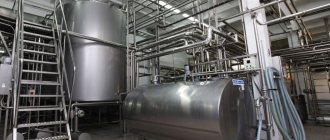Before choosing which milk separator to buy, you need to familiarize yourself with the operating principle of such equipment and the operating rules. We recommend paying attention to several characteristics - electric/manual type of device, power, materials from which it is made, bowl capacity.
Electric or manual
Electric models are efficient and much easier to use in business. In one cycle it is possible to process a larger quantity of products than with the manual type, and in this case the housewife’s hands will remain free. The only drawback of an electric machine is the need for stable, constant electricity.
If you live in an area with intermittent power outages, use a power generator or opt for a portable unit. Both methods are often used in industrial settings. The mechanical type is reliable and easy to use, but requires more effort and time.
Performance
Household separators produce no more than 50-100 liters per hour, excluding breaks for engine rest and washing. On average, a continuous cycle takes half an hour, and the plates must be cleaned after several tens of liters. Be sure to consider these characteristics when comparing them to your job plans and needs.
Material
The reliability, durability and safety of a machine depends on the materials from which it is made. Plastic parts are lightweight, but they are more difficult to clean, they are fragile from scratches and are deformed.
Metal parts are faster to clean, more durable, but heavier. Aluminum accelerates fermentation, but may be susceptible to harsh cleaning agents. The stainless steel design and components are optimal.
Bowl capacity
Adjust this setting according to the amount of raw material being processed. As a general rule, the pan should be at least half full, but not to the brim. The average option that suits most buyers is 5-10 liters, but in production, of course, this will not be enough.
Features of separation at home
Important!
As mentioned, goat milk has a high percentage of fat, but the size of the fat cells is small enough that they can be separated using a manual or slow-moving machine.
Separating goat milk at home differs in the way it is prepared and configured:
- Let sit before loading into the machine - leave the container of milk open or cover with gauze, leave for 1-2 hours. At this time, the goat “spirit” is exhaled from the drink.
- Heat the milk to 42 degrees and run hot water through the separator to heat the container. This will improve separation.
- To separate goat milk, install the device in accordance with the instructions for this type of drink.
- The fat content can be adjusted using the screw on the top plate, but do not set it to the maximum level. A position slightly above the middle is sufficient.
- At the end of the work, you can start returning to the maximum level - this will automatically clear the plates of accumulated oil.
Preparation
Before starting the main process, you need to pass a small amount of hot water, about 70 degrees, through the drum of the device, so that it warms up. Milk is released into the drum only after its normal rotation speed has been reached.
Fresh milk is used for separation. It's best to take a pair. What should the milk temperature be for separation? If it is cold, then it must be heated to about 30 degrees. At this temperature it will degrease better.
Boiled or pasteurized milk, as a rule, is processed much worse, and large fat losses also occur when milk is separated.
Types by drive type
According to this feature, as already mentioned, there are only two types of centrifuges for goat or cow milk
- management;
- electric.
The first type is usually chosen only by owners of small farms. The main advantage of these separators is that they do not require any energy. Devices of this type are inexpensive, and their technical characteristics, especially power, are practically no different from electric models.
The only drawback of this type of separators is that they are not very convenient to use. To get the cream, you need to turn the handle of such a device. This means that processing goat milk in this case turns into a rather tedious procedure.
Electric separators are more convenient to use. However, such a model should only be purchased by those farm owners whose plot is located in a populated area with a stable power supply. Devices of this type may not work, for example, when the network voltage is low. An exception to this rule are some models of old Soviet separators. Currently, such devices are manufactured with motors that are resistant to voltage fluctuations, and even with special signal protection. But, unfortunately, these separators are not very available on the market today.
Principle of operation
Learning more about the operation of the separator will be useful not only for beginners, but also for experienced users. The idea is to use the principle of centrifugal force: the heavy part of the substance is sifted to the side, and the fat is concentrated in the central part. The separation of the substance occurs much more easily with low viscosity and rapid rotation.
Now we propose to consider the operation of this device step by step:
- Filling a bowl with milk from which it flows into a rapidly rotating drum.
- It passes through special holes in the bowl and reaches several separating plates.
- When the drum rotates quickly, centrifugal force acts on the milk, due to which it flows through the grooves of vertical plates.
- In the space between the ceilings, milk is separated into cream and whey.
- The resulting substances move up the drum.
- The cream is discharged through a special channel into the tank, the same thing happens with whey.
- Regulation of the fat level, which occurs due to an increase or decrease in the space near the center of rotation.
Tips for use
Passing goat milk through the separator must, of course, be done correctly. Sometimes it happens that the fat does not separate from the separator. In this case, experienced breeders advise heating goat milk to 30 °C, or even better to 40 °C. The fact is that all these machines are designed for processing mainly fresh goat milk.
Of course, it is not always possible to whip cream immediately after milking. There is usually not much time between them. After all, milk should always be strained after milking. During this process it, of course, cools down. It is not possible to process cold milk into cream using a cream separator.
Experienced farmers advise, among other things, not to set the maximum fat content of goat milk in the machine. In this case, it is better to choose an operating mode slightly above average.
Sometimes it happens that the goat milk separator spills milk. Adjusting the device in this case often does not help. In this situation, simply try to remove and reinstall the separator. This problem is often the result of one of the disks simply being misaligned.
What is the fat content in homemade sour cream?
There are several main types of sour cream: low-fat - 10% fat; medium fat content – 20%; oily – 30%.
Interesting materials:
How to move a file to another Linux folder? How to transfer data from iPhone to MacBook? How to transfer photos from Google Photos to a flash drive? How to transfer photos from VKontakte to the gallery? How to transfer photos from Nokia Lumia to iPhone? How to transfer minutes to the next month of Life? How to transfer a design onto fabric using carbon paper? How to reschedule a court hearing? How to move a table one row down? How to transfer all photos from iPhone to Yandex Disk?
TOP 7 best milk separators
Manufacturers took care of creating two types of separators:
- management;
- electric.
These devices operate on an identical principle; they differ only in the control process. In the rating of the best models, we included 7 manufacturers and brands that meet the standards:
- HYDRAULIC SEPARATOR STSM-80 #18;
- ENGINE SICH-100-18;
- ROTOR;
- NEPTUNE;
- FERMER ES-2.
- OM-3;
- BEREZOVSKAYA HYDROELECTRIC PLANT;
Each block has characteristic features and features, operating principles and uniqueness in management. We will go into detail about all of them, point out the advantages and disadvantages and pay attention to the opinions of buyers and users. Enjoy reading!
HYDRAULIC UNIT SCM-80 No. 18
An unusual device in this category, many people pay attention to the efficient processing of milk. Components and parts are made from high-strength, food-safe aluminum. Productivity per hour is 80 liters.
| Number of plates | 11 |
| Bowl diameter, mm | 365 |
| Height, mm | 530 |
Price: from 3000 to 4300 rubles.
Advantages
- durable material;
- in one hour the exhaust is 80 liters;
- cleaning;
- capacity – 10 liters.
Flaws
- The weight of the device is about 6 kg.
I inherited this unit from my father, who was an active farmer and prepared many of the products himself. I use it to make cottage cheese. This saves me a lot of time and effort and I don't waste energy. I have no complaints about the machine; it does its job quickly and efficiently. It breaks down without interruption and does not overheat.
Milk separator HYDROAGREGAT SCM-80 No. 18
ROTOR
The high efficiency of this model distinguishes it from other devices. Therefore, it is widely used both in domestic conditions and in extensive production. Easy processing of up to 50 liters per hour. An additional advantage of the product is its cleaning from dirt, bacteria and microorganisms, and impurities. The sensor is located on the front panel of the device. This allows the user to independently regulate the operation of the device.
| Bowl, in mm | 280 |
| Device height, mm | 330 |
| Plate | 8 |
Price: from 1490 to 2300 rubles.
Advantages
- 1 year warranty;
- It is sold in two colors - red and yellow;
- The bowl is made of food-grade plastic;
- Light weight of the device – 2.8 kg.
We recently bought this machine, we have a small farm and we want to take our production to the next level. The choice did not take much time; we needed average performance and reliability. Despite the low price, the machine works very well and has never let us down. We fell several times, but the body survived the test.
Milk separator ROTOR
HYDRAULIC UNIT BEREZKA
The device performs additional sorting and disinfection of the product during separation. Moreover, it can be used repeatedly. The bowl is made of high quality, food safe plastic. It is durable, does not heat up and is odorless. With a power consumption of 200 W, the device processes about 60 liters of product per hour and does this almost continuously. Time savings and positive results are key.
Types of separators
The separator is necessary to clean the original product and separate the cream and skim milk. All modern devices are divided into several types, depending on the method of operation. The centrifugal separator is based on the use of centrifugal force. The operation of the vibration separator is ensured by the installation of several sieves connected to a vibration motor. In a settling type separator, clarified milk or cream is removed through the top of the drum.
The centrifugal separator is the most common because it can be in operation for a long time, and allows you to separate up to one hundred liters of milk per hour of operation.
The devices are divided according to the method of milk supply:
- Open type,
- Semi-closed type,
- Closed type.
The sediment from the separator can be removed automatically or manually. A continuous blowing separator with an automatic cleaning system frees the drum from sediment during operation of the device, while a manual separator must be stopped periodically. The continuous blowing separator is more powerful and is more often used in industry than in private households.
Conventionally, separators are divided into industrial and for home use.
Separators "Farmer ES-01": characteristics and reviews
According to many homestead owners, this model is ideal for processing goat milk. This separator is made of plastic. Technical characteristics “Farmer ES-01” has the following features:
- productivity – 80 l/h;
- The ratio of fat and grass can be adjusted from 1:4 to 1:10;
- revolution - 11000-14500
The manufacturer of this model is the domestic enterprise Penzmash. The drum of this model is made of durable stainless food steel and is highly wear-resistant.
Many farmers and homestead owners consider the advantages of this brand of equipment, among other things, that it is perfect for intensive use. Judging by the reviews, the disadvantages of “Farmer” separators include their relatively high cost.
The price of such equipment may vary, depending on the supplier, in the range of 3500-4000 rubles. The Penzmash enterprise today has quite serious production capacities. Therefore, buying a separator for goat milk in Moscow or another city in the country under the “Farmer” brand will not be difficult.
Separator prices
Prices for household milk separators most often depend on motor power (and corresponding performance). Other reasons influencing the price : plastic or metal components, volume of the milk container.
For example,
(TehMos store prices are shown as of January 12, 2022)
- With a separator productivity of 50-60 l/h: price from 2500 to 4200 rubles
- Productivity more than 80-100 l: 4650 - 6500 rub.
- And for farms with large volumes of milk processing, separators with a capacity of 500 l/h or more are suitable. Their cost, of course, is not small: from 140 to 250 thousand rubles.
Separator "Irid": description and reviews
This model is also often used by goat owners to produce cream. The productivity of the Irid separator is 50 liters per hour. The drum of this model reaches operating mode in 15 seconds. The engine is capable of developing 8000-11000 rpm.
This model has received excellent reviews from farmers not only for its ease of use, but also for its reliability. The separators were manufactured in former military-industrial factories. One of their features is the engine with a modern design. This model does not have brushes on the motors. This design not only ensures a long service life of the device, but also allows it to operate as smoothly as possible.
At the moment, this particular model has received the best reviews among farmers and homestead owners. The Irid goat milk separator is one of the few modern models that can operate at a reduced voltage of 160 V.
Ease of use is also considered a plus of equipment of this brand. The fat content of the cream produced by this model can be adjusted using a lever on the front of the cylinder. The drum of the device is made of corrosion-resistant food steel. At the moment, judging by the opinions of farmers on specialized forums, Irid is the best goat milk separator produced in our country.
general information
Dairy products have unsurpassed taste, as well as valuable nutritional properties. Need I say that such products, if properly stored, can be preserved for a very long time? Most farmers and farm owners are wondering where to put all the excess milk. Separation in this case is an excellent solution.
However, this will require a special apparatus called a separator. Thanks to it you can get, for example, cream from whole milk. The principle of separators for separating milk is quite simple and does not require any special knowledge to use. You just need to pour whole milk into the machine, press the button, after which you will receive skim milk and cream after a while. Whole milk contains fat in the form of fat globules. Their density is much lower than the density of the water component of milk. When, during the process of milk separation, the drum of the apparatus is spun under the influence of centrifugal force, this fat begins to gradually separate from the skim milk. Since its density is less, it will be easier to return; as a result, it is forced out to the middle of the drum, after which it is discharged through the drainage system. After separation, the skim milk is discharged through another outlet of the machine.
It is important to note that during separation the working mass is also cleaned of impurities, sediments and mechanical impurities. As a result, you get a healthy and purified food product in the form of skim milk and cream.
Problems using the device
Each machine has an instruction manual that must be carefully read and followed. Possible causes of problems may be design features that were not taken into account during assembly. Some problems can be summarized and basic repair recommendations can be given. However, always pay attention to the model used and the manufacturer's information.
The separated product does not thicken
- The reason may be that the temperature of the milk is too high, in which case it should be cooled to a steam temperature of about 40 degrees.
- You should also get rid of any dirt from the drum. It should be disassembled, cleaned and washed of deposits.
- It would be useful to check the position of the adjusting screw; if it is tightened tightly, turn it 1-1.5 turns.
- After standing in the cold for a long time, the water will thicken. If waiting time is limited, you can use a mixer. The main thing is not to overdo it and not make it oily.
Why does he drive so fat?
The first thing you should try is to change the position of the regulator. The cause may also be milk that is too cold. The optimal temperature of raw milk is 35-45 C. The tap is not fully open. The float is not in place.
Industrial separator
Alfa Laval
The Alfa Laval industrial milk separator is designed to operate in closed systems. The Alfa Laval BTAX 215 separator is available in several versions:
- With integrated pressure discs,
- With pressure discs and protection against overheating and explosions,
- Sealed,
- Sealed with explosion protection.
Milk production in such a separator can reach up to 12 cubic meters per hour of operation. The drum is cleaned using an installed pneumatic system, and solid particles accumulate in special chambers inside the working container.
The hermetic design of the mechanism ensures that the rotor is constantly filled with raw materials, which reduces the risk of oxidation and the proliferation of harmful bacteria.
The standard equipment of the separating device includes:
- Powerful electric motor
- Vibration damper
- A sealed compressed air container equipped with a solenoid valve,
- Vibration control device,
- Sensors that monitor oil pressure.
How to choose a milk separator
Before choosing which milk separator to buy, you need to familiarize yourself with the operating principle of such equipment and the operating rules. We recommend paying attention to several characteristics - electric/manual type of device, power, materials, bowl volume.
Electric or manual
Electric models are efficient and much easier to use in business. In one cycle it is possible to process a larger quantity of products than with the manual type, and in this case the housewife’s hands will remain free. The only drawback of an electric machine is the need for stable, constant electricity.
If you live in an area with intermittent power outages, use a power generator or opt for a portable unit. Both methods are often used in industrial settings. The mechanical type is reliable and easy to use, but requires more effort and time.
Performance
Household separators produce no more than 50-100 liters per hour, excluding breaks for engine rest and washing. On average, a continuous cycle takes half an hour, and the plates must be cleaned after several tens of liters. Be sure to consider these characteristics when comparing them to your job plans and needs.
Material
The reliability, durability and safety of a machine depends on the materials from which it is made. Plastic parts are lightweight, but they are more difficult to clean, they are fragile from scratches and are deformed.
Metal parts are faster to clean, more durable, but heavier. Aluminum accelerates fermentation, but may be susceptible to harsh cleaning agents. The stainless steel design and components are optimal.
Bowl capacity
Adjust this setting according to the amount of raw material being processed. The rule is to fill the pan at least halfway, but not to the brim. The average option that satisfies most buyers is 5-10 liters, but in production this will clearly not be enough.
What to look for when choosing
If you want the device to serve you for a long time and not spoil the overall impression of work with eternal breakdowns, then you should pay attention to the following parameters:
- Material. Separator parts can be made of various materials: plastic, polycarbonate, aluminum. Here each user proceeds from personal preferences and desires. It is worth considering that some plastic models cause difficulties in maintenance, and aluminum ones accelerate the fermentation of raw materials.
- Type. There are two types of separators: electric and manual. The first ones are easy to use, but directly depend on changes in the network.
- Purpose. Basically, the separator is chosen for processing cow's milk, but work with goat's milk is not excluded. The choice of device depends on the number of large or small livestock.
Which milk separator is better?
After reviewing the most commonly purchased home milk separators in 2022, all that remains is to buy one that takes into account your personal needs. Having compared reviews, strengths and weaknesses, the Vyborexperta.ru team highlighted several of the best nominations:
- Milky AR140 is a reliable, quiet model with a good degree of focusing;
- Motor Sich 100-18 is a universal separator for goat milk and other types of products, the best viewing characteristics, durable fastening;
- Tigon Ural-M - a convenient device with a fat control sensor, long service life;
- Penzmash RZ-OPS-M is a multifunctional device with a manual butter beater that does not require electricity.
With so many devices to choose from, finding a suitable and reliable device is not easy. But after reading our review and the evaluation criteria provided, you will be up to the task. All our nominated products are guaranteed to be organic and safe food prepared at home.
Butter
To make butter, you will need a butter churn. Using this device at home, you can make various types of products: peasant, Vologda, sweet-cream, salty, unsalted, sour-cream. The process of separating products in separators also allows you to preserve microbiological properties.
To make butter, cream is used, containing about 30% fat. Preparing them for churning into butter will involve pasteurization, cooling, and also ripening.
They are pasteurized without holding at a temperature of about 90 degrees. The product is kept at this temperature for about 30 minutes. During pasteurization, the cream must be stirred periodically. It is not recommended to transfer pasteurized products to another container. Whip the cream into butter at a temperature of about 10 degrees. The duration of churning is from 15 to 40 minutes.
The churn is filled to no more than 3 quarters of its capacity. Whip the cream until butter grains are formed, the size of which is about 3 mm. To combine the grains into larger ones, you need to make several slow turns using a butter churn. The finished oil is immediately sent to the refrigerator and stored at a temperature of 1 to 4 degrees.
Comparison table of the presented models
Below is a table with the main technical parameters of each device. This will help you choose a model of high quality and performance according to the criteria that best suits your needs.
| Model | Power, W) | Size(mm) | Weight, kg) | Price, rub.) |
| HYDRAULIC UNIT SSM-80 No. 18 | 80 | 529x390x530 | 5 | 3 000 – 4 500 |
| HYDROLOGY OF BIRCH | 200 | 520x365x520 | 4 | 1 500 – 2 700 |
| OMB-3 | 50 | 415x380x295 | 3 | 2 000 – 3 5000 |
| FERMER ES-02 | 80 | 335x290x430 | 3.5 | 3 500 – 5 500 |
| NEPTUNE | 80 | 335x290x430 | 3 | 2 000 – 2 900 |
| ENGINE SICH -100 -18 | 60 | 520x365x520 | 6 | 4 500 – 6 900 |
| ROTOR | 100 | 290x325x460 | 3 | 1 500 – 2 000 |
Additional separator capabilities
Sour cream production
In order to make sour cream, after separation the milk is heated to 36 - 42 degrees, at the same time the separator is heated. Warm water is poured into the milk receiver, and when the machine is warm enough, milk is poured in and it is turned on. A very important part of the process is to adjust the toggle switch so that the milk flows into the working chamber in a thin stream. When the separation of milk is completed, they begin to process the fat remaining in the working chamber for sour cream. All the resulting cream is left warm for a day, and then put in the refrigerator to thicken.
You can get better quality sour cream if you fill the jar 4/5 full.
Oil production
For those who want to obtain homemade oil, a special separator has been developed with an accessory component - an electric oil churn. The milk is purified in the machine, and butter is automatically whipped from the resulting cream. Homemade household butter churns are capable of churning butter from fresh whole milk, as well as from commercial high-fat milk. The Salut butter churner has proven itself well for working at home. It has a built-in tank with a volume of 15 liters, with the ability to load up to 8 liters of cream at a time. The machine churns butter in 15 minutes from cream, and in 30 minutes from sour cream.
Another way to obtain oil is to use special separator equipment, where centrifuges separate the whole raw material into skim milk and cream. Pasteurized milk or cream is heated to a temperature of 30 degrees, and again processed in a separating device with an increased speed and a reduced supply of raw materials into the working chamber.
The milk is fed to the heater, and its temperature rises to 32 - 35 degrees. The device automatically switches to the process of producing cream with a fat content of 40-48. At the same time, the raw material is heated to a temperature of 87 degrees. The heated milk cools down after the separator and enters the oil separator. The skim milk is collected in a special bath, and the thick mass enters the cooling device.
Tips for choosing
Since there are many options for separators, there are some important factors to consider before purchasing to ensure you have the right device for the job.
- Material used. A separator made of metal will be the most reliable, since this material guarantees durability. However, there is nothing wrong with choosing a model with a plastic body or bowl as they are also durable and easy to clean.
- Voltage. Since these products are mainly electrical, the operating voltage must be taken into account. If you connect a high voltage appliance to a lower voltage source, you will not be able to get its maximum power.
- RPM. Often these machines have between 8,000 and 14,000 rpm. This number will be important if goat milk is processed. Therefore, a higher speed machine is required for effective treatment.
- Cream separator capacity. It is always better to choose a large container so that you can process a significant amount of dairy product in one operation. If the model has a small capacity, you will have to clean it frequently. The separator must be disassembled and reassembled, so you will have to spend a lot of time and effort.
- Performance. Separators for home use produce from 50 to 100 liters of dairy product per hour. This is based on performance without taking the device out of service. The average time of continuous operation of the separator is from 30 minutes to 1 hour.
The best milk separator will help simplify the process and produce the highest quality organic dairy products. When choosing a car, pay attention to our rating, in which you will find only proven and high-quality models. Also take a look at the important factors to consider before purchasing a separator to ensure you get a product that suits your needs and avoid disappointment after your purchase.
Main process
You must first tie gauze, folded in several layers, or some other suitable fabric through which the milk can be filtered when filling it, to the receiver of the device.
After this, smoothly and slowly, increasing the speed, the handle of the device rotates up to 65 rpm. If you are using an electric separator, then it must be plugged into the network. When it reaches the required number of revolutions, you need to open the receiver tap, after which the milk will begin to flow into the drum for further separation. To ensure that this process is continuous, milk is periodically poured into the receiver.
The level of cream fat can be adjusted by turning the drain screw, which has a square hole. If you turn the screw to the right, the cream will have more fat. If you turn the screw to the left, the fat content will decrease.
At the end of the separation process, you need to pour up to 1 liter of skim milk into the receiver, without rotating, turn off the device. Wait until the cream flows back out of the hole. This indicates that all the milk fat has been removed from the drum, which means it is necessary to turn off the receiver tap.










